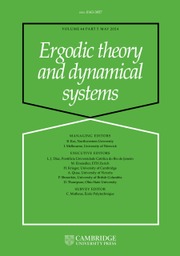No CrossRef data available.
Article contents
Spherical normal forms for germs of parabolic line biholomorphisms
Published online by Cambridge University Press: 07 April 2025
Abstract
We address the inverse problem for holomorphic germs of a mapping of the complex line near a fixed point which is tangent to the identity. We provide a preferred parabolic map  $\Delta $ realizing a given Birkhoff–Écalle–Voronin modulus
$\Delta $ realizing a given Birkhoff–Écalle–Voronin modulus  $\psi $ and prove its uniqueness in the functional class we introduce. The germ is the time-
$\psi $ and prove its uniqueness in the functional class we introduce. The germ is the time- $1$ map of a Gevrey formal vector field admitting meromorphic sums on a pair of infinite sectors covering the Riemann sphere. For that reason, the analytic continuation of
$1$ map of a Gevrey formal vector field admitting meromorphic sums on a pair of infinite sectors covering the Riemann sphere. For that reason, the analytic continuation of  $\Delta $ is a multivalued map admitting finitely many branch points with finite monodromy. In particular,
$\Delta $ is a multivalued map admitting finitely many branch points with finite monodromy. In particular,  $\Delta $ is holomorphic and injective on an open slit sphere containing
$\Delta $ is holomorphic and injective on an open slit sphere containing  $0$ (the initial fixed point) and
$0$ (the initial fixed point) and  $\infty $, where the companion parabolic point is situated under the involution
$\infty $, where the companion parabolic point is situated under the involution  ${-1}/{\mathrm {Id}}$. One finds that the Birkhoff–Écalle–Voronin modulus of the parabolic germ at
${-1}/{\mathrm {Id}}$. One finds that the Birkhoff–Écalle–Voronin modulus of the parabolic germ at  $\infty $ is the inverse
$\infty $ is the inverse  $\psi ^{\circ -1}$ of that at
$\psi ^{\circ -1}$ of that at  $0$.
$0$.
Information
- Type
- Original Article
- Information
- Copyright
- © The Author(s), 2025. Published by Cambridge University Press


